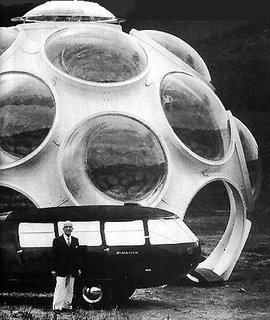Pulling the plug on automotive innovation?
 The Dymaxion Car designed by Buckminster Fuller sported a sleek aerodynamic design and reach speeds of up to 120 miles per hour. Capable of carrying 11 passengers while achieving a fuel efficiency of 30 miles per gallon, its revolutionary design features included three wheels (two in front, one in the rear), a rear engine, rear-wheel steering and front-wheel drive.
The Dymaxion Car designed by Buckminster Fuller sported a sleek aerodynamic design and reach speeds of up to 120 miles per hour. Capable of carrying 11 passengers while achieving a fuel efficiency of 30 miles per gallon, its revolutionary design features included three wheels (two in front, one in the rear), a rear engine, rear-wheel steering and front-wheel drive.A prototype was built in 1933 during the height of the Great Depression and in time for viewing at the Chicago World's Fair.
However, the Dymaxion was involved in an accident at the fair when it was reportedly clipped in the rear by another car causing the prototype to roll over. The driver was killed and the two passengers seriously injured. Fuller was prevented from examining the wrecked vehicle for more than a month.
By that time the publicity surrounding the crash frightened away would-be investors. However, according to Art Kleiner in his book The Age of Heretics, the real reason why Chrysler refused to produce the car was because the bankers threatened to recall their loans fearing its availability would destroy sales of existing automakers.
Earlier this summer I had the opportunity to see "Who Killed The Electric Car?" at the Woods Hole Film Festival. It's a documentary about the curious fate of GM's popular, but short-lived Electric Vehichle -- EV1. I found it to be a disturbing portrayal of the lengths to which vested interests will go to maintain the staus quo.
The EV1 was powered entirely by electricity and was capable of meeting the needs of the average commuter (capable of going 125 miles between recharges). It offered hope that it might bhe possible to significantly reduce our transportation system's dependence on oil. Mass produced EVs would also create an additional incentive to develop wind energy as an indigenous, inexhuastible source of fuel for these zero polluting vehicles.
But like the fuel efficient Dymaxion Car, the EV never made it into mass production. Chris Paine's provocative film attempts to help us understand why. (GW)
 Who Killed the Electric Car? chronicles the life and mysterious death of the GM EV1, examining its cultural and economic ripple effects and how they reverberated through the halls of government and big business. The year is 1990. California is in a pollution crisis. Inspired by a recent announcement from General Motors about an electric vehicle prototype, the Zero Emissions Mandate (ZEV) is born. But the electric car threatened the status quo. The truth behind its demise resembles the climactic outcome of Agatha Christie's Murder on the Orient Express: multiple suspects, each taking their turn with the knife. WHO KILLED THE ELECTRIC CAR? interviews and investigates automakers, legislators, engineers, consumers and car enthusiasts from Los Angeles to Detroit, to work through motives and alibis, and to piece the complex puzzle together.
Who Killed the Electric Car? chronicles the life and mysterious death of the GM EV1, examining its cultural and economic ripple effects and how they reverberated through the halls of government and big business. The year is 1990. California is in a pollution crisis. Inspired by a recent announcement from General Motors about an electric vehicle prototype, the Zero Emissions Mandate (ZEV) is born. But the electric car threatened the status quo. The truth behind its demise resembles the climactic outcome of Agatha Christie's Murder on the Orient Express: multiple suspects, each taking their turn with the knife. WHO KILLED THE ELECTRIC CAR? interviews and investigates automakers, legislators, engineers, consumers and car enthusiasts from Los Angeles to Detroit, to work through motives and alibis, and to piece the complex puzzle together.Year: 2006, Length: 92 min., Format: various, Origin: California, USA Producer/Director: Jessie Deeter, Chris Paine, Cinematographer: Thaddeus Wadleigh, Editor: Michael Kovalenko, Chris A. Peterson

0 Comments:
Post a Comment
<< Home